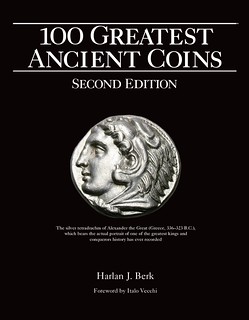
PREV ARTICLE
NEXT ARTICLE
FULL ISSUE
PREV FULL ISSUE
BOOK REVIEW: 100 GREATEST ANCIENT COINS, 2ND ED.Dennis Tucker of Whitman Publications writes: The second edition of 100 Greatest Ancient Coins, by Harlan J. Berk, debuts in March 2019, two weeks before the American Numismatic Association's National Money Show. Here, distinguished European numismatist Italo Vecchi, an award-winning scholarly author himself, reflects on Harlan Berk and the importance of 100 Greatest Ancient Coins.
This is not just a simple reprint of the earlier version. Harlan's selections have been modified and his descriptions and images improved, and he has added a useful summary of ancient gold and silver denominations. Harlan Berk is an internationally renowned coin dealer and art collector whose profound scholarly knowledge applies not only to ancient numismatics, but to early archaeology, Dutch master paintings, the twentieth-century Chicago school of painting, and more, as befits a modern Renaissance man. He follows in the tradition of the early collectors of the Greek, Roman, and Byzantine coins that have fascinated erudite men and women since ancient times. As Suetonius reported of Augustus: "At Saturnalia, or at any other time when the fancy took him, he distributes to his company clothes, gold, and silver; sometimes coins of all sorts, even of the ancient kings of Rome and of foreign nations" (De vita Caesarum 75). Theodora, sister-in-law of Constantine IX, is reputed by Michael Psellus to have "gloated over her collection of darics, for which she had bronze coffers made" (Chronographia 6.63). The fourteenth-century Italian humanist, scholar, and poet Francesco Petrarca, whose discovery of Cicero's letters is often credited with initiating the Renaissance, is also recorded as one of the first known collectors of ancient coins. Other early collectors included Pope Boniface VIII and the emperor Maximilian I. Coin collecting became fashionable among the literati and members of the aristocracy-especially kings and queens-during the Renaissance and was called the "Hobby of Kings." The first known book dedicated exclusively to ancient coins was published in Paris in 1514 by Guillaume Budé: De asse et partibus e jus, the source of which was probably the author's own collection of Greek and Roman coins. Harlan Berk's corpus of 100 remarkable ancient coins is the latest in a long line to hold up a mirror to our nature, allowing us to see ourselves as we were in the classical civilizations of Greece and Rome-cultures much like our own but still tied to slavery and the land, more primitive and casually cruel, yet in outward show and art far more beautiful and, for many periods, inwardly happier and more content (though always threatened, like us, by rising tides of barbarism and internal strife). As a native of Chicago, Harlan will be daily aware of the contrast between opulence and poverty, splendor and misery, that characterise any new Athens, Rome, or Constantinople, yet he has not allowed his friendly and hospitable disposition to be corrupted by pessimism. His wife, Pam Berk, like the amiable spouse of many a devoted numismatist and collector, has long tolerated with patience her husband's obsession, which has made this remarkable catalog of 100 exceptional coins possible. # # # 100 Greatest Ancient Coins, 2nd edition
Dennis Tucker of Whitman Publishing adds: We're excited about the second edition of Harlan's book. He's told me of many collectors who have been inspired to get into ancient coins by reading it. What more can an author (or publisher) ask?
Books can change the world in ways small and large. In this case it's not like there weren't already a lot of people collecting ancient coins, but introducing the topic to a new audience expands the market and helps keep the tradition alive. And course, it means a LOT to the individual reader - it can sometimes be a life-changing event, opening up a whole new world to them. We need authors and publishers more than ever to organize and present all aspects of numismatics to ever-widening audiences. -Editor
To read the earlier E-Sylum article, see:

Wayne Homren, Editor The Numismatic Bibliomania Society is a non-profit organization promoting numismatic literature. See our web site at coinbooks.org. To submit items for publication in The E-Sylum, write to the Editor at this address: whomren@gmail.com To subscribe go to: https://my.binhost.com/lists/listinfo/esylum All Rights Reserved. NBS Home Page Contact the NBS webmaster 
|
